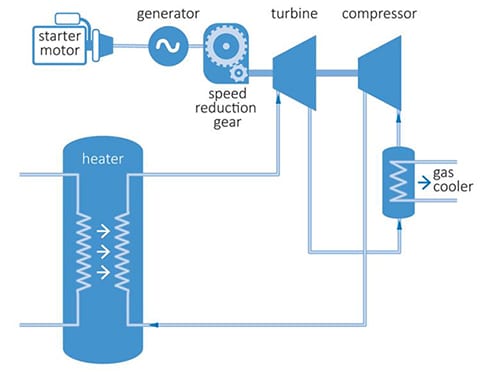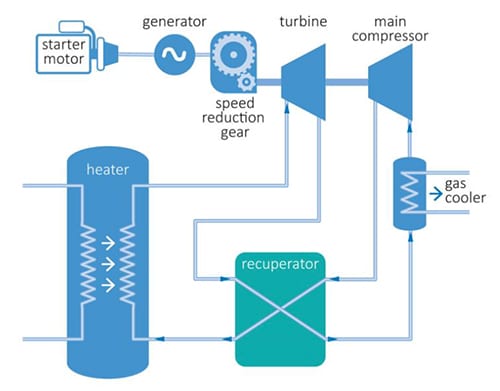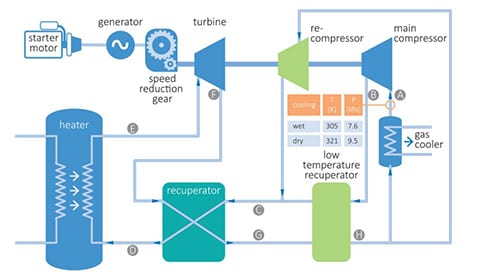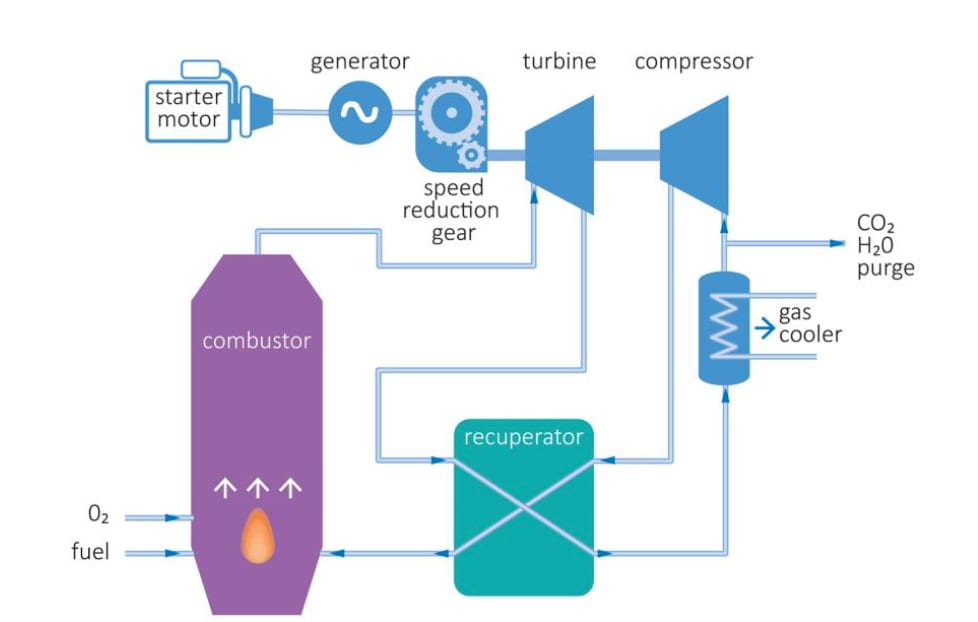What Are Supercritical CO2 Power Cycles?
While conventional power plant cycles produce power from turbines using water or steam as the working fluid, supercritical carbon dioxide (sCO2) cycles use CO2 that is in a supercritical state-at a temperature and pressure above its critical point where liquid and gas phases are not distinguishable.
CO2 has a relatively low critical pressure of 7.4 megapascal (MPa) and a critical temperature of 31C, explained Qian Zhu, a specialist on clean coal technologies at the IEA Clean Coal Centre."A consequence of this is that it can be compressed directly to supercritical pressures and readily heated to a supercritical state before expansion. In a heat engine, this can facilitate obtaining a good thermal match with the heat source. The critical temperature is also sufficiently high for ready heat rejection from the cycle at terrestrial ambient temperatures. Therefore, the system has a great potential for high efficiency since a large temperature difference is available," she said. "CO2 near its critical point becomes more incompressible and hence, the compression work can be substantially decreased leading to high cycle efficiency."
In addition, in its supercritical state, CO2 is also nearly twice as dense as steam, she noted. "The high density and volumetric heat capacity of sCO2 with respect to other working fluids make it more energy dense, meaning that the size of most system components such as turbine and pump can be considerably reduced, which leads to a smaller plant footprint and possibly lower capital costs." sCO2 is also generally considered an ideal working fluid because it is non-explosive, non-flammable, non-toxic, and relatively cheap, she said.
Supercritical-fluid CO2 Live Reaction Recording from Fusion Extracts on Vimeo.
Because it is applicable to most thermal energy sources (such as fossil fuel combustion, nuclear, solar, geothermal, and waste heat recovery), the use of sCO2 in a power system has been explored for decades, and it has undergone constant reinvention. One of the first patents for a partial condensation CO2 Brayton cycle was submitted by Suzler Bros in Switzerland in 1948. Modern interest-and ensuing research and development-in sCO2 power cycles are largely attributed to studies of a sCO2 Brayton cycle for nuclear power in the early 2000s. Today, according to Zhu, investigation of sCO2 power cycles generally fall under two primary approaches: indirectly heated (or indirectly fired) and directly fired cycles.
Indirectly Fired Closed-Loop sCO2 Brayton CyclesResearchers have conducted theoretical studies on numerous sCO2 configurations such as condensation, simple Brayton, precompression, recompression, split expansion, partial cooling, cascade, simple re-heat, and double re-heat cycles. Examples of some variations of this approach are:
Simple Closed-Loop Brayton Cycle.In a simple closed-loop Brayton cycle, the working fluid (CO2) is heated indirectly from a heat source through a heat exchanger (as steam would be heated in a conventional boiler); energy is extracted from the CO2 as it is expanded in the turbine; the CO2 exiting the turbine is then cooled in a heat exchanger to the desired compressor inlet temperature; and after compression to the required pressure, the CO2 is sent back to the heater to complete the cycle. At a turbine inlet temperature (TIT) of 700C and a turbine exit pressure of 8.27 MPa, maximum cycle efficiency is an estimated 34.5%.

A simple indirectly fired, closed-loop Brayton cycle. Courtesy: International Energy Agency (IEA) Clean Coal Centre: "Power generation from coal using supercritical CO2" (2017)
Recuperated Closed-Loop Brayton Cycle.The more advanced recuperated closed-loop Brayton cycle incorporates thermal recuperation through a heat exchanger that is introduced between the expander (the turbine) exhaust and the compressor exhaust. This improves the cycle's efficiency by reducing the amount of heat loss in the CO2 cooler. "A disadvantage to this approach is that, as the heat capacity of CO2 increases significantly with increasing pressure near the CO2 critical point, operating the cycle at pressures in this region will cause the recuperation efficiency to be reduced, limiting the temperature of the high-pressure CO2 that leaves the recuperator," Zhu noted.

An indirectly fired, recuperated, closed Brayton cycle. Courtesy: IEA Clean Coal Centre: "Power generation from coal using supercritical CO2" (2017)
Recuperated Recompression Closed-Loop Brayton Cycle.In a recuperated recompression closed-loop Brayton cycle, the low-pressure CO2 stream exiting from the recuperator is split in two so that one portion is cooled in the cooler and compressed in the main compressor before being heated in the low-temperature recuperator, while the other stream bypasses the cooler and is compressed in the re-compressor to maximum cycle pressure. The streams are then mixed before they pass through a high-temperature recuperator and the CO2 heater. "With this cycle layout, the heat capacity between the hot and cold sides of the recuperator is better matched and hence, the overall efficiency of the recuperator is improved" more than 5% compared to the recompression cycle at optimal pressure ratio, Zhu explained. "However, this configuration is more complex and may have higher costs due to requiring an extra compressor," she said.

An indirectly fired, recuperated, recompression, closed Brayton cycle. Courtesy: IEA Clean Coal Centre: "Power generation from coal using supercritical CO2" (2017)
Waste-to-Heat Recovery Cycle.A system developed by Ohio-based Echogen Power Systems is a multi-stage recuperated closed-loop Brayton cycle where heat from an industrial plant's exhaust stream is recovered though an sCO2 heat exchanger. According to the company, "the turbomachinery pumps the liquid CO2 to high pressure and passes through a combination of recuperators and waste heat exchangers (without using a secondary oil loop) before entering the turbo-expander, which drives the shaft that in turn drives a generator. Effluent CO2 exits the turbine, and passes through a series of recuperators to exchange more heat, and finally enters the condenser where it is converted back to liquid CO2."
Directly Fired CyclesSemi-closed Direct Oxyfuel Brayton Cycle.In semi-closed direct oxyfuel Brayton cycles, the CO2 heater is replaced with a pressurized oxy-fuel combustor. Inside the combustor, fuel is burned in relatively pure and near-stoichiometric oxygen, and the resulting stream-which contains mainly CO2 and water-is used to drive the turbine. After remaining heat in the stream is recuperated, the stream is cooled to condense the water, leaving a high concentration of CO2. One portion of this CO2 is compressed, and then it passes through the recuperator to be preheated to be reused in the combustor (as a diluent), while the other portion is ready to be compressed for storage. According to Zhu, these cycles are well-suited to oxy-combustion of gaseous fuels like natural gas and coal gasification-derived syngas. "Due to the fact that a much higher TIT can be attained in a directly fired sCO2 cycle, cycle efficiencies have the potential to be significantly higher than those of the indirectly heated closed cycles," she said. Meanwhile, "the cycle configuration may be simpler since recompression and other measures for maximising the cycle efficiency are not needed," she added.

A simplified directly fired, semi-closed, oxy-fuel Brayton cycle. Courtesy: IEA Clean Coal Centre: "Power generation from coal using supercritical CO2" (2017)
Allam Cycle. A recently designed specialized sCO2 system, the Allam cycle is directly fired with oxy-fuel, and the exhaust heat is recycled so it can be used to re-heat the CO2 recycling system.

The Allam Cycle. Courtesy: NET Power
Demonstrations UnderwaySeveral demonstrations to validate sCO2 cycles, or parts of them, are underway.
In May 2008, Sandia National Laboratories (SNL) began operations of a breakthrough albeit small-scale sCO2 compression loop. In 2010, it expanded that facility to a 240-kWe simple recuperated test loop, which became one of the world's first sCO2 power-producing cycles. Sandia is now looking to build a "fully operational" 550C, 10-MWe demonstration of its sCO2 Brayton Power Conversion System by the end of fiscal year 2019. The demonstration will "allow the systematic identification and retirement of technical risks and testing of components for the commercial application of this technology," it says.
The U.S. Department of Energy (DOE) has also furnished Echogen and Southern Research with $1 million as part of the SunShot initiative to design, model, and test a novel integrated sCO2 power cycle and thermochemical energy storage system for concentrated solar power. According to the DOE, the award period is slated to end in October 2019. The team is expected to design, build, and test a prototype-scale sCO2 power cycle and reactor to validate the design and performance of the system. Echogen, meanwhile, already produces the 7.5-MWe EPS100, the first megawatt-rated commercial-scale sCO2 heat engine.
Last October, construction began at the 10-MWe Supercritical Transformational Electric Power (STEP) pilot plant at Southwest Research Institute's (SwRI's) San Antonio, Texas, campus. The project stems from a successful effort to design, build, and test a 1-MWe test loop-which consists of a 1-MWe turbine (with a 10-MWe frame size), a novel air-to-sCO2 heat exchanger (made of Inconel 740H), and a commercial dense-phase pump. That effort involved testing a 5-MWth printed circuit recuperator sourced from Vacuum Process Engineering, and a 2.5-MWth air-to-sCO2 primary heater with an inlet temperature of 470C and outlet of 715C.
The first demonstration of the Allam cycle is also underway in La Porte, Texas. The 50-MWth (25-MWe) plant, using natural gas, is being developed by NET Power, a partnership between Exelon Generation, McDermott, 8 Rivers Capital, and if regulators approve a recent investment decision, Oxy Low Carbon Ventures. First fire at the plant was achieved on May 30, 2018, and NET Power is actively assessing a site for the first 300-MWe commercial plant, which it could deploy as early as 2021. (For more about this project, and a 5-MWe coal-fired Allam Cycle pilot under development, see, "Inside NET Power: Gas Power Goes Supercritical.")
-Sonal Patel is a POWER associate editor.
The post What Are Supercritical CO2 Power Cycles? appeared first on POWER Magazine.